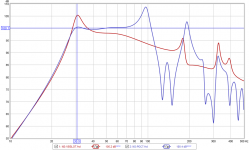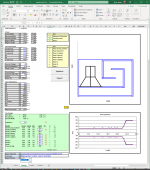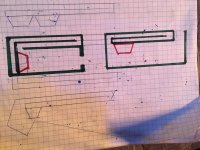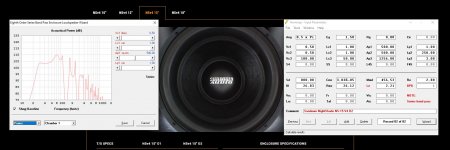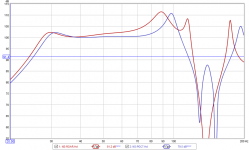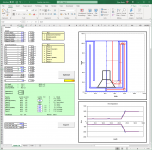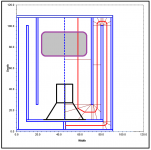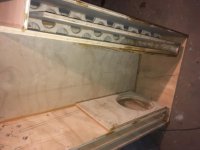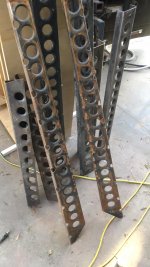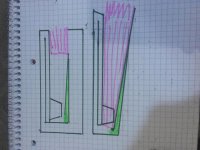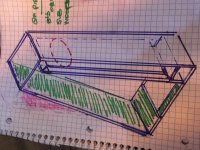I've been asked to assist with a car audio build that's using a Sundown NightShade NS-15 V4 D2 to provide bass duties. Sundown recommends a 4.25 cu.ft. tuned to 32 Hz and I've put together a bog-standard vented box design that meets those specs. Hornresp suggests that the build will produce a fairly big peak at around 30 Hz and starts rolling off about 60 Hz.
For a lark though, I also put together a POC7 TH design for the driver that's only slightly larger (2 inches deeper) and the results look interesting. The rolloff is reduced (as is the peak at 30 Hz) and, apart from a peak around 100 hz that can be reduced with EQ, it looks like it has a fairly decent usable passband.
I don't know how this driver will actually perform in a TH though. Is anyone here familiar with it?
For a lark though, I also put together a POC7 TH design for the driver that's only slightly larger (2 inches deeper) and the results look interesting. The rolloff is reduced (as is the peak at 30 Hz) and, apart from a peak around 100 hz that can be reduced with EQ, it looks like it has a fairly decent usable passband.
I don't know how this driver will actually perform in a TH though. Is anyone here familiar with it?
Attachments
This is the design I'm considering. It's sort of a "half-ROAR", configured that way to accomplish the longer path and deeper chamber required by this particular woofer. I'm not sure that we will proceed with this though - this is for car audio subwoofer duty, and the owner might be more interested in that big peak at 30 Hz... 
Attachments
I'm not sure that we will proceed with this though - this is for car audio subwoofer duty
I have never heard a Helmholtz based car audio box get anywhere near the physical impact of a tapped pipe/high order QW design - regardless of driver or amplifier power.
My latest HROAR12 humiliates every single 12 or 212 BR design that it is compared to. Both is raw spl and in percieved sound quality. There is no comparison.
That Sundown driver has a reasonably low Qts and seems to be quite suited to high order QW duty. It would be shame to spoil its potential stellar performance with the use of Helmholtz.
What is the maximum alowable size of the box?
Here's how the response of the POC7 and your ROAR sim compare under the same conditions (2PI loading, 2.83V, calculated semi-inductance parameters for the NS15). The ROAR goes a bit lower and it's a bit louder at higher bass frequencies. It's also a bit bigger, but not by much. I think it's worthy of consideration for this build, as they have some space to spare in the car. The question of course is if that Hornresp sim can be turned into a box that can actually fit into the car...
Attachments
Brian, use your generic qw pipe math for the folded initial path. Then use the necesary csa for the third section (after the s2/3 taps to clear the pole vent and allow cooling. use L45 as the mass loading exit window, and L23 as the the bulk of that chamber. In TH1 mode theres some freedom. Not suggesting its perfect, but i am claiming the use of vtc/Atc even with AP1/Lp will land on an electrical impedance in the sim and measured versions. not just tge first two peaks/nulls. And you can see the falacies in red LE in this way tooo(seperate topic, but worth mentioning).
I'm using a special ROAR workbook that I put together to chuck out the Hornresp parameters when I provide particular box dimensions. To get down to a 32 Hz Fb requires a pretty deep box, but apparently there's enough space in the car for this.
I don't use "red Le" ("lossy Le") in my sims. Instead I use derived semi-inductance parameters, obtained from the driver's impedance curve.
I have to update the workbook though, to include some enhancements that I've made to my other workbooks.
I don't use "red Le" ("lossy Le") in my sims. Instead I use derived semi-inductance parameters, obtained from the driver's impedance curve.
I have to update the workbook though, to include some enhancements that I've made to my other workbooks.
Attachments
I would actually recomend against using a standard ROAR in a car. The very large cross section of the QW front resonator is damped to much by the car cabin at high spl.
The HROAR design is better suited for car audio in my experience.
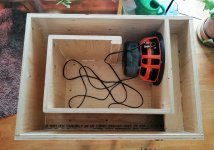
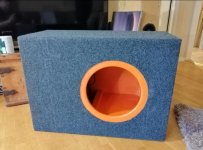
Something like this.
The box should be 900 mm wide, 700 mm tall and 542 mm deep outside dimentions (21 mm plywood).
The tapped pipe section cross section is 500 x 100 mm. The Helmholtz front resonator is 616 x 416 x 500 mm (w x h x d).
The tapped pipe sections seems to end up about 245 cm long if shorted enough for the 35 cm mounting depth of the huge magnet of the NS series of Sundown audio drivers.
The HROAR design is better suited for car audio in my experience.


Something like this.
The box should be 900 mm wide, 700 mm tall and 542 mm deep outside dimentions (21 mm plywood).
The tapped pipe section cross section is 500 x 100 mm. The Helmholtz front resonator is 616 x 416 x 500 mm (w x h x d).
The tapped pipe sections seems to end up about 245 cm long if shorted enough for the 35 cm mounting depth of the huge magnet of the NS series of Sundown audio drivers.
I 100% agree and totally have run into this issue audibly and also in paraflex it gets nasty in a vehicle. I deferred to the roar (h) style for that reason. I would prefer the vent position to be a bit different but in my experience im going to say that is only a visual anomoly as the ‘offset’ port can be a huge benefit to harmonic junk.
intentionally offsetting that exit a bit from the end of the wall opposite the driver wall(none of which us easy to see in that design) is huge in upward response issues or higher order harmonics
intentionally offsetting that exit a bit from the end of the wall opposite the driver wall(none of which us easy to see in that design) is huge in upward response issues or higher order harmonics
I would actually recomend against using a standard ROAR in a car. The very large cross section of the QW front resonator is damped to much by the car cabin at high spl.
The HROAR design is better suited for car audio in my experience.
View attachment 899719
View attachment 899720
Something like this.
The box should be 900 mm wide, 700 mm tall and 542 mm deep outside dimentions (21 mm plywood).
The tapped pipe section cross section is 500 x 100 mm. The Helmholtz front resonator is 616 x 416 x 500 mm (w x h x d).
The tapped pipe sections seems to end up about 245 cm long if shorted enough for the 35 cm mounting depth of the huge magnet of the NS series of Sundown audio drivers.
Last edited:
Topologically, I'm not seeing much of a difference between the two layouts. The split path is replaced by a single path, and the resonator section is replaced with a differently-shaped resonator with an offset "vent". This may modify the response at the upper end of the passband, but that's less important to me than what's going on below about 60 Hz.
In any case, I plan to use a similar offset vent with the ROAR layout I pictured (see attached image). It is a bit larger than the HROAR design, simply because there's enough available space in the car to do so. This nets a few dB extra in the passband, according to the sim. It of course also means that there will be some deviation between the sim and the actual response at the upper end of the passband.
In any case, I plan to use a similar offset vent with the ROAR layout I pictured (see attached image). It is a bit larger than the HROAR design, simply because there's enough available space in the car to do so. This nets a few dB extra in the passband, according to the sim. It of course also means that there will be some deviation between the sim and the actual response at the upper end of the passband.
Attachments
Topologically, I'm not seeing much of a difference between the two layouts. The split path is replaced by a single path, and the resonator section is replaced with a differently-shaped resonator with an offset "vent". This may modify the response at the upper end of the passband, but that's less important to me than what's going on below about 60 Hz.
In any case, I plan to use a similar offset vent with the ROAR layout I pictured (see attached image). It is a bit larger than the HROAR design, simply because there's enough available space in the car to do so. This nets a few dB extra in the passband, according to the sim. It of course also means that there will be some deviation between the sim and the actual response at the upper end of the passband.
I have the same thing except it uses two 12” drivers Knowhere near the same as the sundance nightshade. Thats in a league of its own i think
Attachments
Last edited:
Topologically, I'm not seeing much of a difference between the two layouts. The split path is replaced by a single path, and the resonator section is replaced with a differently-shaped resonator with an offset "vent".
That is why I see them as two members of the same family. There are more differences then that but in broad terms they are topological similar.
The HROAR (Helmholtz front resonator) is more optimized for car cabins and other smaller venues like small rooms, Home Theater and mid sized Theater setups. The "pure" QW ROAR is much better suited looking out over a large crowd of people at a dub festival. The pure ROAR is not a very nice aquintance to get up close and personal with. The two different front resonators does shape the spl-dependent transfer function in quite different ways.
And the split path of the original ROAR does lower the Q of the tapped pipe section quite substantially in an spl-dependent manner, which is a design feature to increase the performance at high spl levels outdoors where the acoustic space does not add any damping.
A car cabin is a quite different acoustic enviroment and does demand a quite different approach. The highly damped and acousticaly "cramped" space will damp the front resonator Q much more at high spl. This is why a Helmholtz resonator with a comparably smaller port works better att driving this acoustic space. The HROAR only have a single tapped pipe to maximize the TP resonator Q. It is very heavily damped by the car cabin so you don´t need the split path design to damp the Q.
Modern high power density car bass drivers are quite robust and built for heavy abuse of bassheads not understanding that the intensely glowing clip indicator of the poweramp is not a "joy-indicator". They can take the uneven loading of a single path TP much better then pro drivers with their much lighter cones, tighter voice coil gap and looser spiders and suspensions.
I don´t want to discourage you from building a modified ROAR for car use, but my experience from the last few years of building quite a few HROAR and ROAR designs mainly for car audio usage points to large potential performance gains in the rather unique car cabin acoustic enviroment from the very simple to build HROAR design over the more complex and more pro audio optimized classical QW based ROAR.
Last edited:
Circlomanen. I think your Hroar vent opening makes a tremendous difference in the HF junk that is caught in the vehicles cabin space as standing wave disasters and audible confusion to many peoples ears. The standard ROar has a wide open large mouth and anything can come out of it from inside the cabinet. Another cabinet that is better suited for PA has the same issues in small spaces and could use the same treatment as the hroar or similar for vehicle use and i have experimented with the method a bit in a few versions and it seems to be somewhat affective.
roar and paraflex certainly kick asssss in a PA outdoor use, but both greatly improve as small space/indoor/vehicle subwoofers using an exit shape and size like the hroar. In fact any thing seems to benefit with a large expanding path that ends with a restriction just before the jump to ambient? Bonus points are found in an offset position of that from the ‘loading wall’ at the ‘end’ which could be a phase shift in the short distance between it and the frequencies of that offset length are thus removed.
roar and paraflex certainly kick asssss in a PA outdoor use, but both greatly improve as small space/indoor/vehicle subwoofers using an exit shape and size like the hroar. In fact any thing seems to benefit with a large expanding path that ends with a restriction just before the jump to ambient? Bonus points are found in an offset position of that from the ‘loading wall’ at the ‘end’ which could be a phase shift in the short distance between it and the frequencies of that offset length are thus removed.
I am hoping that no aspect of this design's performance turns out to be "SPL-dependent", at least until the driver runs out of linear throw or the car starts giving up  .
.
My POC3 showed less than 0.3dB variation in passband performance until the driver started running out of Xmax, and I'm hoping for better results than that with a driver that cost a good deal more than the one I used in the POC3.
I'm considering a slight variation on the ROAR that starts the flare from the penultimate bend rather than the last one. This might change the shape of the passband a bit - I'll found out soon enough when my workbook chucks out the corresponding Hornresp parameters.
My POC3 showed less than 0.3dB variation in passband performance until the driver started running out of Xmax, and I'm hoping for better results than that with a driver that cost a good deal more than the one I used in the POC3.
I'm considering a slight variation on the ROAR that starts the flare from the penultimate bend rather than the last one. This might change the shape of the passband a bit - I'll found out soon enough when my workbook chucks out the corresponding Hornresp parameters.
Bonus points are found in an offset position of that from the ‘loading wall’ at the ‘end’ which could be a phase shift in the short distance between it and the frequencies of that offset length are thus removed.
That's part of the intent of the offset vent in my design. It should be relatively easy to predict what frequencies will be impacted as well.
- Status
- This old topic is closed. If you want to reopen this topic, contact a moderator using the "Report Post" button.
- Home
- Loudspeakers
- Subwoofers
- Sundown NS-15 V4 D2 build...
